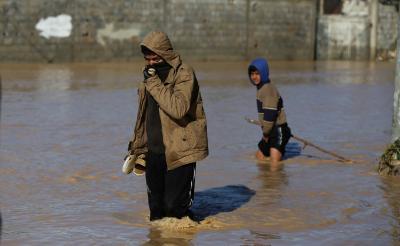
UN Reacts After Heavy Rains Flood Displaced Families In Gaza
The rains had a harsh impact on people across the Gaza Strip, with damage to personal belongings and thousands of displaced families left fully exposed to the harsh weather, increasing health and protection concerns, especially for older people, those with disabilities and other vulnerable groups, said OCHA.
Partners reported that proper flood prevention requires equipment that is not available in Gaza, including tools to drain water away from tents and to clear solid waste and rubble. Millions of urgently needed shelter items remain stuck in Jordan, Egypt and Israel, awaiting approvals to enter Gaza, the office said.
OCHA said that since the October 10 ceasefire, the Israeli authorities have rejected 23 requests from nine partners to bring into Gaza nearly 4,000 pallets of critical supplies, including tents, sealing and framing kits, bedding, kitchen sets and blankets, Xinhua news agency reported.
Shelter partners said that the main barrier remains restrictive registration rules for non-governmental organizations. In all but two of the 23 rejections, the reason given was that the submitting organizations were not authorized to deliver humanitarian aid into Gaza.
OCHA said that about 1,000 tents were distributed to families in Deir al-Balah and Khan Younis on Thursday. Between Sunday and Wednesday, partners provided about 7,000 blankets to more than 1,800 households, some 15,000 tarpaulins to more than 3,700 households, and winter clothing to more than 500 households.
"The dire living conditions are also increasing people's exposure to explosive ordnance, with children among those most at risk," the humanitarian office said.
"Some people have been injured while collecting firewood; others are having to pitch tents near areas suspected of containing unexploded remnants simply because they have no safer options," it said.
OCHA said that since the ceasefire, partners working on mine action have recorded more than 10 injuries from explosive hazards. Such risk is further compounded by Gaza's limited geographical size, which leaves little room to avoid areas suspected of contamination.
Since the ceasefire, partners have responded to more than 70 requests for explosive hazard assessments, supported 32 inter-agency missions, and delivered risk education sessions to over 49,000 people across the Gaza Strip.
The UN Mine Action Service reported that it could do much more as soon as teams get access to detectors, spare parts and equipment needed to dispose of explosive hazards safely.

Legal Disclaimer:
MENAFN provides the
information “as is” without warranty of any kind. We do not accept
any responsibility or liability for the accuracy, content, images,
videos, licenses, completeness, legality, or reliability of the information
contained in this article. If you have any complaints or copyright
issues related to this article, kindly contact the provider above.


















Comments
No comment